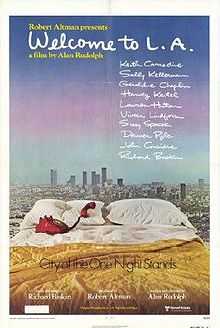Welcome to L.A.
| Welcome to L.A. | |
|---|---|
 | |
| Directed by | Alan Rudolph |
| Produced by |
Robert Altman Scott Bushnell Robert Eggenweiler |
| Written by | Alan Rudolph |
| Starring |
Keith Carradine Geraldine Chaplin Sally Kellerman Harvey Keitel Lauren Hutton Viveca Lindfors Sissy Spacek Denver Pyle Richard Baskin |
| Distributed by | United Artists |
| Release dates |
12 November 1976 Washington, Seattle Premiere 10 March 1977 New York City |
| Running time | 106 Min |
| Language | English |
Welcome to L.A. is a 1976 film directed by Alan Rudolph and starring Keith Carradine.
Plot
The theme of romantic despair and shallowness is displayed utilizing a La Ronde-like circle of sexual adventures and failed affairs centered around songwriter Carroll Barber (Carradine), which spread out through the city. Barber is an aloof womanizer who cannot commit or love and is used to illustrate the loneliness inherent in big-city life.
The film features a continual score by Richard Baskin, present throughout, and features a lonely real estate agent (Sally Kellerman), a Valley housewife addicted to taxi rides (Geraldine Chaplin), the mistress of Barber's father (Lauren Bacall), a housekeeper who vacuums topless (Sissy Spacek) and a troubled businessman (Harvey Keitel).
Barber is a songwriter of mediocre talent, who is nonetheless supported financially, with enthusiasm, by his wealthy father (Denver Pyle). An inveterate womanizer, he has affairs with the real estate agent who found his apartment, and whose husband, a successful businessman, covets their maid. He also beds the wife of the businessman, who is the C.O.O. of his dad's successful dairy. Barber even includes his father's mistress among his conquests.
Cast
- Keith Carradine as Carroll Barber
- Sally Kellerman as Ann Goode
- Harvey Keitel as Ken Hood
- Lauren Hutton as Nona Bruce
- Sissy Spacek as Linda Murray
- Viveca Lindfors as Susan Moore
- Denver Pyle as Carl Barber
- John Considine as Jack Goode
Critical reception
Jack Kroll of Newsweek described the film as an "extraordinary debut" for Rudolph, continuing that the director "does a remarkable job of weaving this gallery of neurotics into a vivid pattern of sharp, distilled performances." Kroll also considered Rudolph's work with Robert Altman, "he's gone beyond even Altman's example in shaping a film from a total design concept." Furthermore, he praised Rudolph for creating a "Los Angeles that's shimmering Xanadu of psychic uncertainty. Mirrors reassemble people into soulless human collages. The swoosh of Hutton's ever-present Nikon sounds like a little guillotine beheading reality. The quavering cadences of Baskin's music evoke both the sweetness and self-indulgence of Carroll Barber. Cinematographer Dave Myers works like the new realist painters, capturing a metropolis of burnished surfaces that seems to dissolve the will in an amber nullity of light."[1]
Geraldine Chaplin was nominated for a British Academy Film Award for Best Supporting Actress.
References
- ↑ Kroll, Jack. Slippery City. Newsweek. 21 February 1977
External links
| |||||